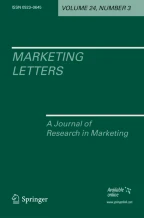Abstract
It has been suggested theoretically that consumer attitudes have distinct hedonic and utilitarian components, and that product categories differ in the extent to which their overall attitudes are derived from these two components. This paper reports three studies that validate measurement scales for these constructs and, using them, show that these two attitude dimensions do seem to exist; are based on different types of product attributes; and are differentially salient across different consumer products and behaviors, in theoretically-consistent ways.
Similar content being viewed by others
References
Bagozzi, Richard P. (1980). Causal Models in Marketing. New York: Wiley.
Bentler, P. M., and D. G. Bonett. (1980). “Significance Tests and Goodness of Fit in the Analysis of Covariance Structures,” Psychological Bulletin 24, 163–204.
Fornell, C., and Larker, D. F. (1981). “Evaluating Structural Equation Models with Unobservable Variables and Measurement Error,” Journal of Marketing Research 18, 39–50.
Holbrook, M. B. and E. C. Hirschman. (1982). “The Experiential Aspects of Consumption: Consumer Fantasies, Feelings, and Fun,” Journal of Consumer Research 9, 132–140.
Joreskog, Karl G., and Dag, Sorbom. (1985). LISREL VI: Analysis of Linear Structural Equations by Maximum Likelihood, Instrumental Variables and Least Squares Methods. Mooresville, IN: Scientific Software.
Komorita, S. S., and A. R. Bass. (1967). “Attitude Differentiation and Evaluative Scales of the Semantic Differential,” Journal of Personality and Social Psychology 6, 241–244.
Levin, Joseph. (1965). “Three-Mode Factor Analysis,” Psychological Bulletin 64 (6), 442–452.
Millar, M. G., and Tesser, A. (1986). “Effects of Affective and Cognitive Focus on the Attitude-Behavior Relationship.” Journal of Personality and Social Psychology 51, 270–276.
Myers, James H., and Allan, D. Shocker. (1981). “The Nature of Product-Related Attributes,” in J. N. Sheth (ed.), Research in Marketing, Vol. V. Greenwich, CT: Jai Press, 211–236.
Osgood, C. E., G. J. Suci, and P. H. Tannenbaum. (1957). The Measurement of Meaning. Urbana, IL: University of Illinois Press.
Sirgy, M. J. (1982). “Self-Concept in Consumer Behavior: A Critical Review,” Journal of Consumer Research 9(3): 287–300.
Triandis, H. C. (1977). Interpersonal Behavior. Monterey, CA: Brooks/Cole Publishing Co.
Vaughn, Richard. (1986). “How Advertising Works: A Planning Model Revisited,” Journal of Advertising Research 26 (1), 57–66.
Author information
Authors and Affiliations
Rights and permissions
About this article
Cite this article
Batra, R., Ahtola, O.T. Measuring the hedonic and utilitarian sources of consumer attitudes. Marketing Letters 2, 159–170 (1991). https://doi.org/10.1007/BF00436035
Issue Date:
DOI: https://doi.org/10.1007/BF00436035
